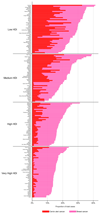The global burden of women's cancers: a grand challenge in global health
- PMID: 27814965
- PMCID: PMC6191029
- DOI: 10.1016/S0140-6736(16)31392-7
The global burden of women's cancers: a grand challenge in global health
Abstract
Every year, more than 2 million women worldwide are diagnosed with breast or cervical cancer, yet where a woman lives, her socioeconomic status, and agency largely determines whether she will develop one of these cancers and will ultimately survive. In regions with scarce resources, fragile or fragmented health systems, cancer contributes to the cycle of poverty. Proven and cost-effective interventions are available for both these common cancers, yet for so many women access to these is beyond reach. These inequities highlight the urgent need in low-income and middle-income countries for sustainable investments in the entire continuum of cancer control, from prevention to palliative care, and in the development of high-quality population-based cancer registries. In this first paper of the Series on health, equity, and women's cancers, we describe the burden of breast and cervical cancer, with an emphasis on global and regional trends in incidence, mortality, and survival, and the consequences, especially in socioeconomically disadvantaged women in different settings.
Copyright © 2017 Elsevier Ltd. All rights reserved.
Conflict of interest statement
Figures








Comment in
-
Civil society's role in efforts to control women's cancers.Lancet. 2017 Feb 25;389(10071):775-776. doi: 10.1016/S0140-6736(16)31799-8. Epub 2016 Nov 1. Lancet. 2017. PMID: 27814966 No abstract available.
-
Women's cancers: shining a light on a neglected health inequity.Lancet. 2017 Feb 25;389(10071):771-773. doi: 10.1016/S0140-6736(16)31798-6. Epub 2016 Nov 1. Lancet. 2017. PMID: 27814968 No abstract available.
-
Women, power, and the cancer divide.Lancet. 2017 Feb 25;389(10071):773-774. doi: 10.1016/S0140-6736(17)30071-5. Lancet. 2017. PMID: 28248158 No abstract available.
References
-
- Vos T, Barber RM, Bell B, et al. Global, regional, and national incidence, prevalence, and years lived with disability for 301 acute and chronic diseases and injuries in 188 countries, 1990– 2013: a systematic analysis for the Global Burden of Disease Study 2013. [accessed online August 8, 2015];Lancet. 2015 doi: 10.1016/S0140-6736(15)60692-4. ePub June 7. - DOI - PMC - PubMed
-
- Soerjomataram I, Lortet-Tieulent J, Parkin DM, et al. Global burden of cancer in 2008: a systematic analysis of disability-adjusted life-years in 12 world regions. Lancet. 2012 Nov 24;380(9856):1840–50. - PubMed
-
- Ferlay J, Soerjomataram I, Dikshit R, et al. Cancer incidence and mortality worldwide: sources, methods and major patterns in GLOBOCAN 2012. Int J Cancer. 2015 Mar 1;136(5):E359–E386. - PubMed
-
- Sullivan R, Olusegun IA, Anderson BO, et al. Cancer surgery: delivering safe, affordable and timely cancer surgery. The Lancet Oncology. 2015;16:1193–1224. - PubMed
Publication types
MeSH terms
Grants and funding
LinkOut - more resources
Full Text Sources
Other Literature Sources
Medical
Molecular Biology Databases

